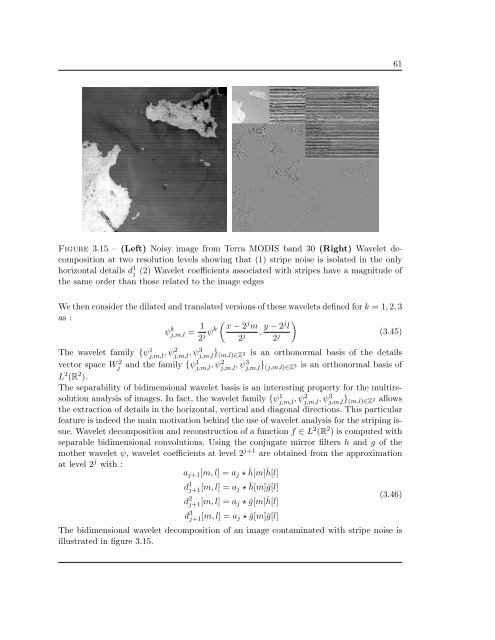Th`ese Marouan BOUALI - Sites personnels de TELECOM ParisTech
Th`ese Marouan BOUALI - Sites personnels de TELECOM ParisTech
Th`ese Marouan BOUALI - Sites personnels de TELECOM ParisTech
Create successful ePaper yourself
Turn your PDF publications into a flip-book with our unique Google optimized e-Paper software.
61<br />
Figure 3.15 – (Left) Noisy image from Terra MODIS band 30 (Right) Wavelet <strong>de</strong>composition<br />
at two resolution levels showing that (1) stripe noise is isolated in the only<br />
horizontal <strong>de</strong>tails d 1 j (2) Wavelet coefficients associated with stripes have a magnitu<strong>de</strong> of<br />
the same or<strong>de</strong>r than those related to the image edges<br />
We then consi<strong>de</strong>r the dilated and translated versions of these wavelets <strong>de</strong>fined for k =1, 2, 3<br />
as :<br />
ψj,m,l k = 1 ( x − 2 j m<br />
2 j ψk 2 j , y − )<br />
2j l<br />
2 j (3.45)<br />
The wavelet family {ψj,m,l 1 ,ψ2 j,m,l ,ψ3 j,m,l } (m,l)∈Z 2 is an orthonormal basis of the <strong>de</strong>tails<br />
vector space Wj 2 and the family {ψ1 j,m,l ,ψ2 j,m,l ,ψ3 j,m,l } (j,m,l)∈Z3 is an orthonormal basis of<br />
L 2 (R 2 ).<br />
The separability of bidimensional wavelet basis is an interesting property for the multiresolution<br />
analysis of images. In fact, the wavelet family {ψj,m,l 1 ,ψ2 j,m,l ,ψ3 j,m,l } (m,l)∈Z 2 allows<br />
the extraction of <strong>de</strong>tails in the horizontal, vertical and diagonal directions. This particular<br />
feature is in<strong>de</strong>ed the main motivation behind the use of wavelet analysis for the striping issue.<br />
Wavelet <strong>de</strong>composition and reconstruction of a function f ∈ L 2 (R 2 ) is computed with<br />
separable bidimensional convolutions. Using the conjugate mirror filters h and g of the<br />
mother wavelet ψ, wavelet coefficients at level 2 j+1 are obtained from the approximation<br />
at level 2 j with :<br />
a j+1 [m, l] =a j ⋆ ¯h[m]¯h[l]<br />
d 1 j+1[m, l] =a j ⋆ ¯h[m]ḡ[l]<br />
d 2 j+1[m, l] =a j ⋆ ḡ[m]¯h[l]<br />
d 3 j+1[m, l] =a j ⋆ ḡ[m]ḡ[l]<br />
(3.46)<br />
The bidimensional wavelet <strong>de</strong>composition of an image contaminated with stripe noise is<br />
illustrated in figure 3.15.















